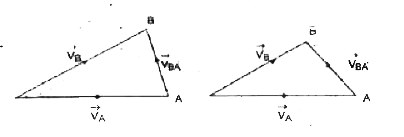Can the relative velcity ot two bodies be greater than the absolute velcity of either body.
Yes, when two bodies are moving in opposite directions along a straight path, then the relative velocity of each body is greater than the absolute velocity of eigher body.
Topper's Solved these Questions
- KINEMATICSBOOK - PRADEEPCHAPTER - KINEMATICSEXERCISE - 2 Very short
22 Videos
- KINEMATICSBOOK - PRADEEPCHAPTER - KINEMATICSEXERCISE - 3 Very short
46 Videos
- KINEMATICSBOOK - PRADEEPCHAPTER - KINEMATICSEXERCISE - 4 Con ceptual Problems
22 Videos
- GRAVIATIONBOOK - PRADEEPCHAPTER - GRAVIATIONEXERCISE - Assertion-Reason Type Questions
19 Videos
- LAWS OF MOTIONBOOK - PRADEEPCHAPTER - LAWS OF MOTIONEXERCISE - Assertion- Reason Type Questions
17 Videos
Similar Questions
(A): Relative velocity of A w.r.t. B is greater than the velocity of either, when they are moving in opposite directions.
(R): The relative velocity between any two bodies is equal to the sum of the velocities of the two bodies.
View SolutionStatement-1 : The relative velocity between any two bodies moving in opposite direction is equal to sum of the velocities of two bodies. Statement-2 : Sometimes relative velocity between two bodies is equal to difference in velocities of the two.
View Solution
Knowledge Check
Assertion: Relative velocity of A w.r.t B is greater than the velocity of either, when they are moving in opposite directions.
Reason: Relative velocity of A w.r.t B=→vA−→vBAIf both assetion and reason are true and the reason is the correct explanation of the assertion.BIf both assertion and reason are true but reason is not the correct explanation of the assertionCIf assertion is true but reason is falseDIf the assertion and reason both are false.The vector difference between the absolute velocities of two bodies is called their relative velocity. The concept of relative velocity enables us to treat one body as being at rest while the other is in motion with the relative velocity. This jormalism greatly simplifies many problems. If →vAis the absolute velocity of a body A and →–––(B)that of another body B then the relative velocity of A in relation to B is →–––(AD)=→VA−→vB and →vBA=→vB-→vA.
The principle follows here is that the relative velocity of two bodies remains unchaged if the same additional velocity is imparted to both the bodies. A simple way of carrying out this operation is to be represent the velocities in magnitude and direction from a common point. Then the line joining the tips of the vectors represents the relative velocity
Q A train A moves to the east with velocity of 40 km/hr and a train B moves due north with velocity of 30 km/hr. The relative velocity of A w.rt. B is A70 km/hr towards EastB10 km/hr towards North EastC50 km/hr at some angle South of EastD50 km/hr at some angle North of East.
A70 km/hr towards EastB10 km/hr towards North EastC50 km/hr at some angle South of EastD50 km/hr at some angle North of East.Assertion: Density of hollows body is always less than the density of substance of equal mass of the body.
Reason: Volume of hollow body is greater than the volumeof substance of the body. But mass of hollow body is equal to mass of substance of the body.ABoth Assertion & Reason are true & the Reason is a correct explanation of the Assertion.BBoth Assertion & Reason are true & the reason is not a correct explanation of the Assertion.CAssertioin is true but the Reason is false.DAssertion and Reason are false.
Why is the speed in general, greater than the magniude of the velcity ?
View SolutionThe density of a stationary body is equal to ρ0. Find the velocity (relative to the body) of the reference frame in which the density of the body is η=25% greater than ρ0.
View SolutionWhen distant between the centres is less than sum of radii and greater than their absolute difference.
View SolutionWhen the velcity of flow of liquid is greater than critial velocity, the liquid is said to have
View SolutionThe ratio of relative velocity of separation after collision to the relative velocity of approach before collision between two colliding bodies is ____________.
View Solution
